Exploring Lunar Phases and Their Effects on Surfing
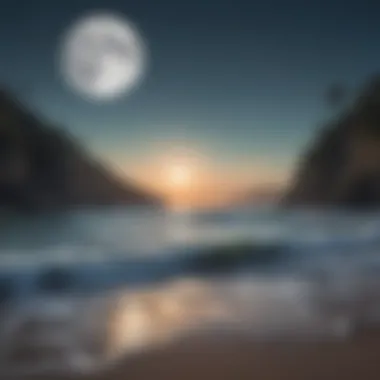
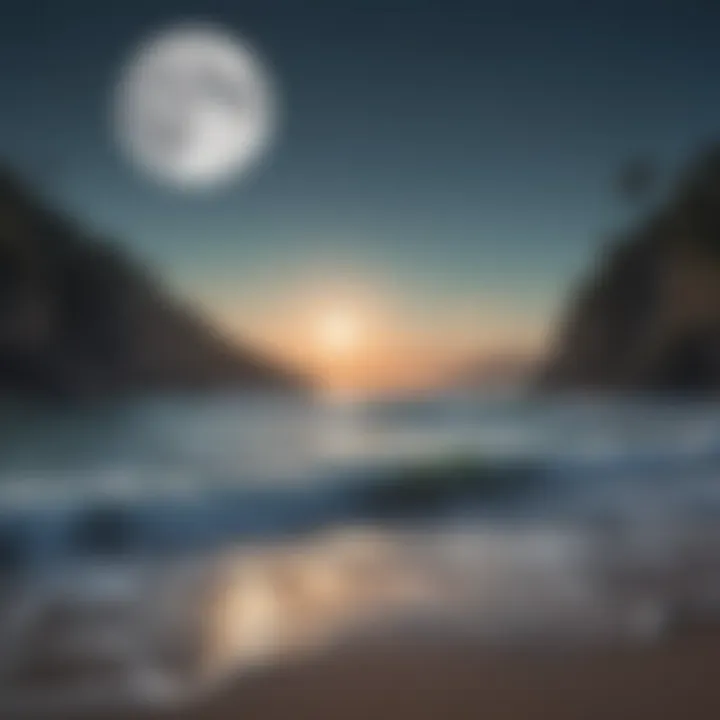
Intro
Understanding the moon and its phases isn’t just a matter of good poetry or romantic evening strolls on the beach. For surfers, it’s like learning the language of the sea. The moon affects ocean tides, which in turn influences the waves we ride. This connection forms the crux of many surfboards tales whispered around beach bonfires, yet not many delve deeply into these celestial influences.
The significance of lunar phases is often underestimated. From the waxing and waning moon to the depth of the tides, every aspect can help you score that perfect wave or even add zest to your surfing experience. Hence, if you’ve ever wondered why one night’s surf feels different from another, it’s high time to unravel this mystery.
This article will explore how contemporary lunar phases shape surf conditions, diving into crucial insights from both the scientific and practical perspectives. We will look into historical contexts, the motions of ocean tides, and weather patterns. Additionally, experienced surfers will discover ways to enhance their surfing skill set by leveraging this knowledge.
As we navigate through the lunar waters, expect to encounter direct applications of tidal knowledge that can transform your time on the waves. Learn not only about the lunar impact but also how various surfboard designs factor in. So, buckle up, grab your board, and let’s ride the moon's cycle!
Surfboard Reviews
Selecting the right surfboard can feel akin to finding a needle in a haystack. With so many options on the market, it’s worth understanding the types of surfboards available and which best suit different surfing conditions.
Types of Surfboards: An Overview
- Shortboards: Known for their agility and speed, shortboards are the choice of wave riders looking for radical moves. They’re ideal for experienced surfers who want tight boards to maneuver through powerful waves.
- Longboards: Emphasizing stability and ease, longboards are perfect for beginners. Their length allows for smoother rides, making them great for catching smaller, slower waves.
- Fish Boards: With a unique shape that resembles a fish, these boards excel in small to medium waves. They balance width and length to enhance paddling ease.
- Funboards: A hybrid between shortboards and longboards, funboards provide versatility. They are great for progressing surfers who want a mix of performance and stability.
Choosing the right board means aligning your skill level, the type of waves you tackle, and, notably, the lunar phase affecting those waves.
Best Surfboards for Beginners and Pros
For beginners, opting for a soft-top longboard is wise. The softness mitigates injury risks while learning the ropes of balance and vim on a board. Alternatively, experienced surfers might consider high-performance shortboards like the Lost Mayhem or Channel Islands. These boards are crafted to enhance speed and responsiveness in powerful surf conditions, especially under optimal tidal influences brought by the lunar phases.
When assessing the best surfboards for specific conditions, it's critical not to dismiss the overarching conditions influenced by the moon. Tidal patterns will dictate the swell. Surfing with this in mind can mark the line between riding the wave of the decade or missing it entirely.
"Understanding the conditions brought on by lunar phases can significantly elevate a surfer's experience, as the tide dances are affected by the lunar calendar."
As we discuss specific techniques further, we will explore how beginners and pros alike can harness lunar dynamics when hitting the surf. Stay tuned as we paddle deeper into the fold!
Prelude to Lunar Phases
Lunar phases are more than just an aesthetic element in the night sky; they hold tangible impact in our daily lives, particularly for surfers. Understanding lunar phases involves grasping how the different stages of the moon affect oceanic behavior, tides, and, consequently, surfing conditions. As surfers venture out into the waves, many may not realize that their timing can greatly depend on these celestial changes.
The presence and visibility of the moon can influence not only the amplitude of tides but also the formation and quality of waves. This interplay between lunar phases and oceanic conditions sets the stage for more effective and safe surfing practices. Moreover, knowing the moon's cycle may help surfers plan trips around ideal conditions, allowing them to maximize their time on the water.
Definition and Overview
A lunar phase refers to the different appearances of the moon as observed from Earth, influenced strictly by its position relative to the sun and Earth. These phases originate from the moon's orbit around our planet, which, depending on its alignment, results in various shapes we see—new moon, first quarter, full moon, and last quarter being the primary stages.
Each of these phases lasts approximately 29.5 days, marking a complete lunar cycle. The cycles are further subdivided into waxing (growing) and waning (shrinking) phases, leading to a dynamic celestial ballet. This transformation is not merely a visual spectacle; it has implications on tides and wave patterns that surfers need to understand.
Historical Significance of Lunar Phases
Historically, lunar phases have captured human imagination and shaped cultures across the globe. Ancient maritime civilizations relied heavily on the moon to navigate the seas, and their surf culture intertwined with lunar cycles becomes apparent. For instance, Polynesians harnessed lunar knowledge for navigation and fishing, understanding that specific phases brought larger and more plentiful fish near shores.
Throughout history, various communities have woven lunar phases into their calendars, rituals, and traditions. Farmers would plant crops according to the moon’s cycle, while sailors often adjusted their plans to align with these phases. Today, surfers can draw from this historical understanding, recognizing that centuries of observation can enhance their own experiences in the surf.
Understanding the contemporary significance of lunar phases can empower modern surfers, inviting them to embrace a deeper connection with their surroundings while riding the waves.
Current Moon Phase Analysis
Understanding the current moon phase is not merely an exercise in astronomy; it’s a strategic compass for surfers keen on optimizing their time on the waves. The moon plays a crucial role in defining ocean conditions, shaping everything from tides to wave quality. By dissecting the current moon phase, surfers can better anticipate the ebb and flow of the ocean, making informed decisions that could significantly enhance their surfing experience. Here, we will highlight the benefits and considerations surrounding the current moon phase analysis, giving attention to practical tools that help track lunar cycles.
Identifying Today’s Moon Phase
To determine today's moon phase, one could simply observe the night sky and match the moon's appearance to a lunar phase chart; however, this method can sometimes be hit or miss. Instead, many surfers opt for reliable online resources or lunar apps that provide precise updates. For instance, using applications like Moon Phase Pro or even calendar websites can yield accurate lunar phase data alongside tide charts.
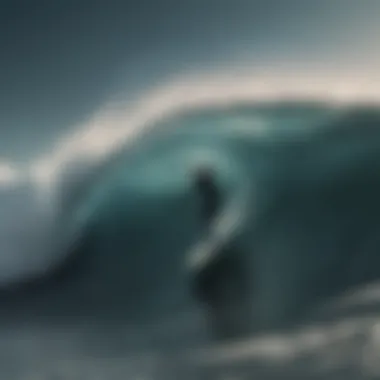
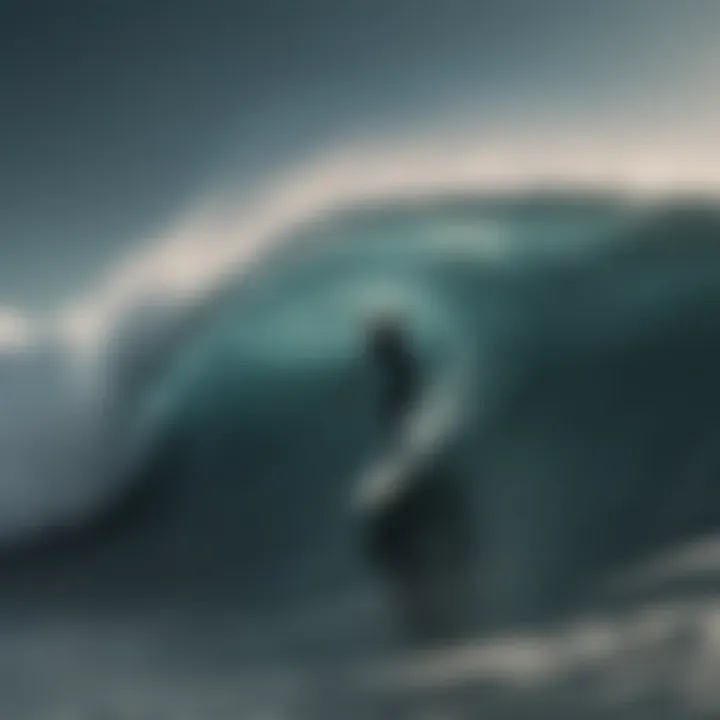
A quick note: if you’re surfing today, knowing whether it’s a new moon or a full moon can shape your expectations. During a new moon, the tides can shift significantly, resulting in bigger and more powerful swells, attracting surfers eager for a challenge. Conversely, a full moon can bring in high tides that cover different breaks, altering wave formations. Understanding these differences ensures that surfers can select the ideal time to hit the beach.
Visual Representation of the Moon
Visualizing the moon phase is all about clarity and creating connections between what the eye sees and what happens with the ocean. Many surfers might not realize how such a small sliver of light can mean different things for wave conditions.
To aid in this understanding, consider including a simple lunar phase image representing the different phases:
- New Moon - The moon is completely dark; effects on tides can lead to energetic surf.
- First Quarter - Half-lit; creates progressive tides.
- Full Moon - When the moon is fully bright, tides might be highest, affecting visibility and surf conditions.
- Last Quarter - Similar to the first quarter, can lead to a mix in tide behavior.
"Lunar phases influence not just the tides but the very rhythm of the ocean itself. A well-informed surfer uses this knowledge to adapt and thrive on the waves."
This understanding can further be enhanced with tide chart visualizations that correlate lunar phases. Many surfers carry printed tide graphs with them while traversing beaches. An astute surfer can visually match the moon’s state with tide conditions, resulting in a more intuitive experience in the water.
By marrying these visual tools to one's surfing practices, local knowledge and lunar understanding can come together, ensuring that the waves are not just a series of peaks and troughs but rather, sequences laden with meaning and opportunities.
The Science Behind Lunar Cycles
The study of lunar cycles unveils a fascinating interplay between celestial mechanics and earthly phenomena. Understanding how these cycles operate is crucial for surfers seeking to harness optimal conditions and navigate the undulating rhythms of the ocean. The moon’s gravitational pull has direct effects on tides, wave formations, and even local weather patterns. These elements combine to create a dynamic environment in which surfers can enhance their skills, safety, and enjoyment.
Lunar Cycle Mechanics
The lunar cycle consists of the phases the moon goes through approximately every 29.5 days. This cycle includes new, waxing crescent, first quarter, waxing gibbous, full, waning gibbous, last quarter, and waning crescent phases.
During its journey, the moon's position relative to Earth illuminates different portions, which in turn impact gravitational forces felt on Earth.
- Gravitational Influence: As the moon orbits our planet, its gravity tugs at the ocean, causing water levels to rise and fall—what we know as tides. At high tide, the increased water level supports more robust wave formation, whereas low tide might expose more rocky areas, changing conditions entirely.
- Timing and Waves: It’s not just the height of the tide that matters; the timing is crucial too. For example, many surfers prefer to paddle out around high tide or just after it peaks, maximizing chances for the best waves.
"The positioning of the moon aligns with the sun also influences surf conditions. During a full moon, the combined gravitational forces produce higher tides, often leading to more dynamic surf."
Lunar Phases and Tidal Patterns
Tides consistently change with the lunar phases, creating a rhythm that many surfers start to attune to. Understanding how this relationship functions can be as essential as mastering technique.
- Spring Tides: Occur during the new and full moon when the sun and moon are aligned. This alignment creates the highest and lowest tides, generating bigger waves in many locations. Surfers should keep an eye on these periods for potentially ideal conditions.
- Neap Tides: Happen during the first and last quarters when the moon is at right angles to the sun. The difference between high and low tide is lessened, which can make for calmer waters. Some surfers may find this advantageous for learning or practicing less challenging conditions.
Ultimately, the connection between lunar phases and tidal patterns isn’t just theoretical—it’s a tangible element of the surf experience. As surfers strategize their outings, the moon serves as a silent guide, subtly steering them towards the best conditions and safety. By being attuned to these cycles, the surfing community can elevate their experience on the waves, ensuring their enjoyment and safety simultaneously.
Impact of the Moon on Ocean Behavior
The moon plays a crucial role in shaping the dynamics of ocean behavior, particularly through its influence on tides and wave formation. Understanding how lunar phases affect the ocean can offer surfers profound insights into when and where to catch the best waves, as well as to ensure safety. Grasping these concepts empowers surfers and outdoor enthusiasts, fostering a deeper connection with the natural world around them.
Understanding Tides
Tides, essentially the regular rise and fall of sea levels, are primarily driven by the gravitational pull of the moon. As the moon orbits the Earth, it exerts a force that affects the water in the oceans, creating two high tides and two low tides within a 24-hour period. This phenomenon isn’t just crucial for mariners and fishers; for surfers, the timing of tides can significantly impact wave conditions.
In specific terms, high tides can enhance wave quality, creating larger swells and more powerful breaks, while low tides may expose underwater features, potentially leading to smaller waves but also unique surf spots.
"Understanding the tide schedule is half the battle when looking for the perfect wave—timing is everything."
Some locations can be more predictable than others; for instance, certain beaches may experienced consistent high tides influenced by different lunar phases. The spring tide, occurring during a full or new moon, often results in extreme tidal effects, amplifying the risks and opportunities for surfers. Knowing these patterns can give an edge when planning surf sessions.
Influence on Wave Formation
The connection between the moon and wave formation is a fascinating aspect of surfing. As tidal movements push water up onto the shore, they create a specific energy that contributes to how waves form. Depending on whether it's low or high tide, surfers might find that waves break differently; some beaches favor different phases for optimal conditions.
Here are a few key factors to consider regarding wave formation and lunar influence:
- Wave Height: Generally, strong tidal currents during high tide can create taller, more formidable waves, suitable for advanced surfers.
- Wave Frequency: Often, the period between waves may vary significantly depending on the tide, impacting the surfer's ride.
- Wave Shape: The topography of the ocean floor becomes more influential at different tides, as can be seen in reef breaks and sandbars where specific formations will catch waves better.
- Wind Patterns: The interaction between tides and winds can determine the surface quality of waves. Light offshore winds during a high tide might yield clean, rideable waves.
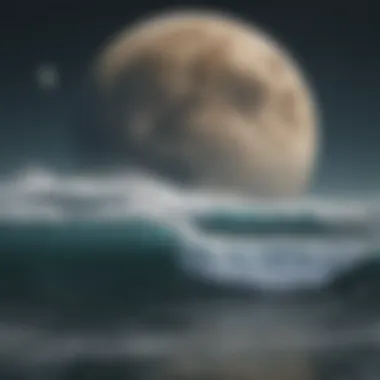
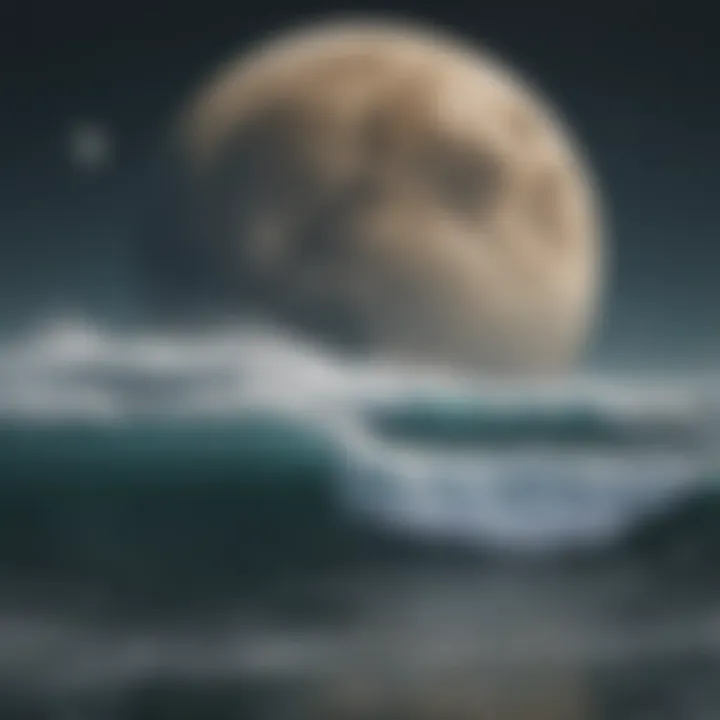
Surfers who pay close attention to these details can enhance their experience significantly by choosing the right time based on the lunar calendar. A deeper understanding of tides and their correlation with waves can not only increase enjoyment on the water but also cultivate a respect for the lunar forces at play in coastal environments.
Surfing Considerations Related to Moon Phases
The relationship between moon phases and surfing is more than just a watery coincidence; it holds a treasure trove of insights that can significantly enhance a surfer's experience. Understanding the influence of lunar cycles on the ocean is crucial, as it dictates various surf conditions, including tide patterns, wave size, and even marine wildlife behavior. Surfers, whether seasoned or newbies, can gain tremendous benefits from aligning their surf schedule with these natural rhythms.
Optimal Conditions Influenced by Lunar Cycles
As the moon waxes and wanes, it exerts a gravitational pull on Earth's water bodies, influencing tides and current flows. Timing your surf sessions with the right moon phase can bring a dramatic difference in wave quality. For instance:
- Full Moon: This phase tends to generate higher tides and can lead to more powerful waves. Experienced surfers chase these adrenaline-pumping conditions.
- New Moon: Just like full moons, new moons also create significant tides. These might not seem as intense, but they can facilitate pristine surf spots free from usual crowds.
- First and Last Quarter: Interestingly, these phases create more moderate tidal patterns which can be appealing for beginner surfers who want calmer waves to practice on.
By keeping an eye on slab-like swells and planning accordingly, surfers can hit the waves when conditions are at their prime. Tracking lunar cycles allows surfers to harmonize their sessions with nature's rhythm, anticipating the behavior of tides and currents.
Safety Considerations During Specific Phases
While the allure of bigger waves during certain moon phases is enticing, safety should remain a priority. It’s important for surfers to recognize that conditions can also be less forgiving. For instance:
- Strong Tides: A full moon can bring about particularly strong tide shifts. This can lead to powerful rip currents, making it necessary for surfers to be cautious.
- Visibility Issues: Nights with a new moon deprive surfers of natural light. Surfers should avoid night sessions during this time unless they are experienced enough and familiar with their chosen spots.
- Local Wildlife Activity: Some marine species are more active during specific lunar phases, leading to safety considerations like increased shark sightings or jellyfish blooms. Those planning to surf often should keep abreast of local reports and conditions.
"Knowledge is the first step to safety on the waves. Understanding the moon's phases guides smarter choices for surfers."
Ultimately, a well-informed surfer is a wiser surfer. By factoring in the behaviors tied to lunar cycles, surfers can forge a deeper connection with the ocean, ride safer, and ultimately have more fulfilling experiences in the water.
Cultural Interpretations of Lunar Phases
Lunar phases have been woven into the cultural fabric of societies throughout history, influencing traditions, and beliefs that go far beyond simply tracking time. Acknowledging the deeper meanings attached to the moon’s cycles can provide surfers insights into their own practices and rituals. These interpretations extend beyond simple folklore; they affect community behavior, surfing schedules, and even how people perceive the ocean's temperament.
Folklore and Beliefs
In many cultures, the moon is more than just a celestial body. It's a powerful symbol, often linked with femininity, emotions, and the natural ebb and flow of life. For surfers, understanding these beliefs may enrich their experience on the waves. For instance, in certain coastal communities, the full moon is considered a time of heightened energy and is believed to attract larger fish or stir up larger waves. This common belief can lead surfers to venture out during full moons in hopes of catching bigger swells.
Moreover, some folk tales speak of spirits or deities dwelling in the moonlight, influencing both ocean and weather conditions. Such stories are not merely entertainment; they serve as a reminder of the interconnectedness of the natural world. Surfers, who often spend a considerable amount of time in the ocean, might find these cultural narratives resonate with their own experiences, adding a layer of spirituality to their passion.
"The moon and its phases are often seen as a reflection of our own cycles in life. Just like the tide, we all ebb and flow, constantly changing and adapting."
Celebrations and Rituals
Many surf communities hold festivities aligned with lunar cycles. These celebrations are sometimes connected to local lore or the harvest cycles of fisherman. Take, for instance, the Hawaiian tradition of celebrating the Makahiki season, which corresponds with the new moon. This period is dedicated to rest, reflection, and sports, promoting the spirit of community, fun, and competition.
Such cultural celebrations often include surfing competitions, communal beach gatherings, and traditional meals that honor the sea’s bounty. In this way, the lunar calendar not only marks time but also unifies the community, fostering a sense of belonging among surfers, instructors, and lifeguards alike.
Beyond Hawaii, many cultures around the world engage in moonlit beach gatherings, utilizing this time for introspection or connection with nature. These communal rituals often align with observing lunar phases for practical reasons; surfers may find that various moon phases yield varying wave patterns, thus synchronizing their gatherings with optimal surfing conditions.
More so, seasonal rites or full moon ceremonies from different cultures have also been adapted by surfers pioneering to find the perfect wave. This merging of tradition with sport showcases the ongoing influence of lunar cycles not just on tides, but also on community dynamics.
In essence, recognizing and respecting these cultural interpretations can deepen one’s connection to the ocean and enhance the overall surfing experience. The moon remains a guiding force in both practical and mystical senses, influencing everything from ocean behavior to community practices.
Practical Tools for Moon Phase Tracking
Tracking lunar phases is not just for stargazers or astronomers. For surfers, understanding the lunar cycle can provide them with invaluable insights into wave patterns and tide behaviors. By employing the right tools, one can seamlessly align their surfing experience with the rhythms of the moon, giving them a leg up in their endeavors on the water.
Lunar Calendars
Lunar calendars serve as a time-tested method to keep tabs on the moon’s various phases. Even though digital tools are all the rage these days, there's something undeniably charming about a printed lunar calendar hanging neatly on your wall. These calendars outline each phase of the moon—from new to full and everything in between—on a yearly basis.
Benefits of Using Lunar Calendars:
- Visual Tracking: One glance at a lunar calendar can tell you exactly where we are in the lunar cycle, helping you plan your surf trips ahead of time.
- Holistic Understanding: Many calendars also come with additional info, such as the best fishing and gardening days according to lunar phases, providing a broader context.
- Local Focus: Depending on where you get your calendar, some may offer tide charts specific to your region, aligning coastal conditions with the moon’s influence.
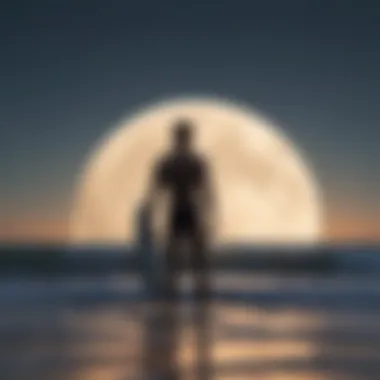
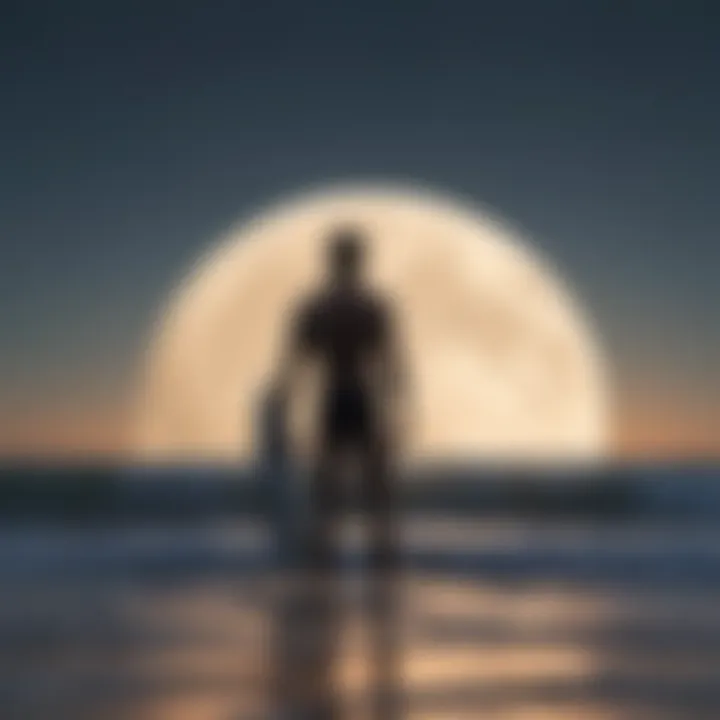
Things to Consider:
- Not all calendars are created equal. Make sure to choose one that focuses on your region’s tides and surfing conditions.
- A pocket-sized version might be handy for quick references while at the beach.
In summary, a good lunar calendar is like having a weather forecast for your surfing adventures, but based on the moon’s influence.
Mobile Applications for Monitoring Phases
In our fast-paced world, having a handy app on your smartphone for tracking the moon is a game-changer. Numerous applications are specifically designed for moon phase tracking, catering not just to casual observers but also to the surfing community. These apps present data dynamically, giving real-time updates that can help surfers make educated decisions right when they need them.
Advantages of Using Mobile Applications:
- Real-Time Updates: Get notifications about moon phases, tides, and even alerts for optimal surfing conditions.
- Customization Options: Many apps allow users to customize settings based on geographical location, providing localized tide forecasts.
- Community Features: Some apps also offer forums or social features which allow surfers to share insights, upcoming sessions, and personal tips on how the moon affects their surfing experience.
Considerations:
- Battery life can be essential when you’re at the beach. Make sure your phone is charged.
- Check app reviews to ensure you pick one that provides reliable and accurate information.
To sum it up, mobile applications have become a lifeline for surfers keen to stay in the know about moon phases. They combine convenience with functionality, putting a wealth of information right at your fingertips.
"Understanding the moon phases can turn a regular surf day into an extraordinary one."
This blend of techniques—using both lunar calendars and mobile applications—gives surfers a well-rounded toolkit for navigating the ocean’s dynamics, creating a solid foundation for an enhanced surfing experience.
The Interrelationship of Moon Phases and Surfing Community
In the world of surfing, understanding the moon’s phases isn’t merely an academic pursuit; it’s a vital part of the sport’s culture. The lunar cycle can dramatically influence wave conditions, the timing of tides, and even the behavior of marine life. By dissecting how these celestial rhythms interact with local surf conditions, surfers can better equip themselves to ride the waves at just the right moment.
When discussing the interrelationship between moon phases and the surfing community, it’s crucial to highlight the different ways in which surfers have traditionally integrated lunar knowledge into their practice. Experienced surfers often tend to check the moon phase before hitting the water. This isn’t just superstitious fluff; data suggests that certain phases bring on more favorable conditions for surfing.
For instance, many believe that full moons attract higher tides, which can offer more powerful waves. Conversely, a new moon might produce lower but more consistent swells. Therefore, recognizing these patterns can yield a tactical edge when planning surf sessions.
Community Practices and Experiences
The collective knowledge accrued within the surfing community showcases a fascinating tapestry of practices oriented around the lunar calendar. Many surfers pass down anecdotes and tips from older generations, creating a rich lore around optimal times for surfing based on moon phases.
- Full Moon Gatherings: Some surf spots organize night surf sessions during full moons. The allure of surfing under moonlight draws in surfers and creates a unique community vibe.
- Shared Rituals: Surfers often schedule trips aligned with particular lunar phases, enhancing camaraderie as they anticipate peak conditions together. It’s not uncommon to witness groups gathering around beach bonfires, recounting tales of epic waves ridden during specific phases.
By establishing these traditions, communities not only foster an appreciation for the sport but also nurture a sense of belonging. It elevates local surf culture, making it deeply intertwined with lunar influences, thus enriching each surfing experience.
Sharing Knowledge and Insights
In the age of digital communication, the sharing of knowledge relating moon phases to surfing has expanded beyond local communities. Various online platforms, including Reddit and Facebook groups, afford surfers the opportunity to trade insights and observations about lunar effects on surf conditions.
- Forums and Social Media: Surfing enthusiasts share personal anecdotal evidence regarding how specific moon phases have influenced their sessions, whether good or bad. From discussions about unusual wave behavior during waxing moons to debates about ideal timings for adrenaline-packed night surfing, the discussions add depth to collective understanding.
- Workshops and Local Meetups: Many local surf shops offer workshops where seasoned surfers share their expertise on lunar cycles. These sessions often involve tide charts and moon calendars, facilitating hands-on learning that merges traditional knowledge with modern technology.
"The ocean speaks a language, and the moon is its translator." This notion resonates within the surfing community, cementing the idea that lunar awareness is both a practical and cultural cornerstone for surfers worldwide.
By fostering an environment of shared knowledge and collaborative learning, surfers not only enhance their own experiences but contribute to a deeper, collective wisdom that makes the sport rich and fulfilling.
Culmination
In wrapping up this exploration of lunar phases and their impact on surfing, it’s clear that understanding these celestial rhythms is not just for the poets or dreamers. For surfers, they hold tangible benefits that can change the game. Each phase of the moon, from the new moon to the full moon and everything in between, has its own unique effect on the tides, which ultimately influence wave conditions. This relationship is not merely theoretical; it’s a practical aspect of surfing that can determine the best times to catch significant swells.
Summarizing Key Insights
We’ve uncovered several key insights throughout this article:
- Lunar Influence: The position of the moon alters tidal movements, which is crucial for surfers looking for optimal wave conditions.
- Behavior Patterns: Certain moon phases can lead to predictable behaviors in both the ocean and marine life, crucial for those looking to time their adventures.
- Community Connection: Surfing knowledge is often shared within communities, where experienced surfers pass down insights regarding lunar phases and their implications for surfing conditions.
"By synchronizing their activities with lunar phases, surfers can enhance their chances of enjoying more favorable conditions on the water."
The Future of Lunar Awareness in Surfing
Going forward, the future of lunar awareness in surfing seems bright. With technology improving, surfers have greater access to real-time information about moon phases and their corresponding tidal impacts. Apps and lunar calendars can aid even the novice surfer in making informed decisions. As more surfers become aware of these connections, the surfing community might see a shift towards a more informed practice, embracing a deeper respect for the rhythms of nature. Encouraging engagement with local ecosystems could foster a broader consciousness that benefits both surfers and the environment. Embracing this knowledge not only enhances the surfing experience but also enriches the overall relationship surfers have with the ocean and its cycles.















